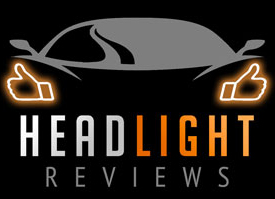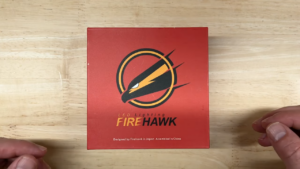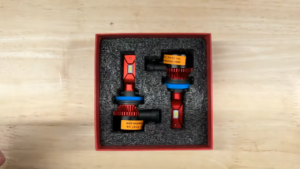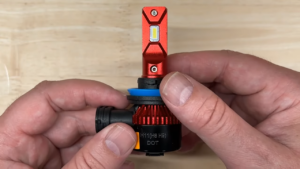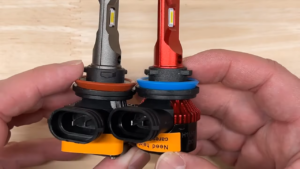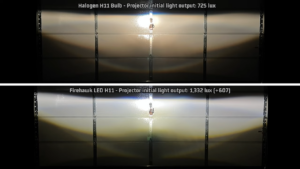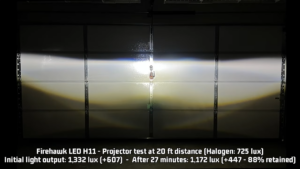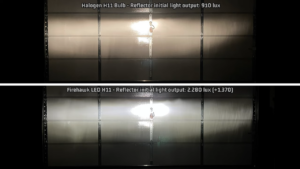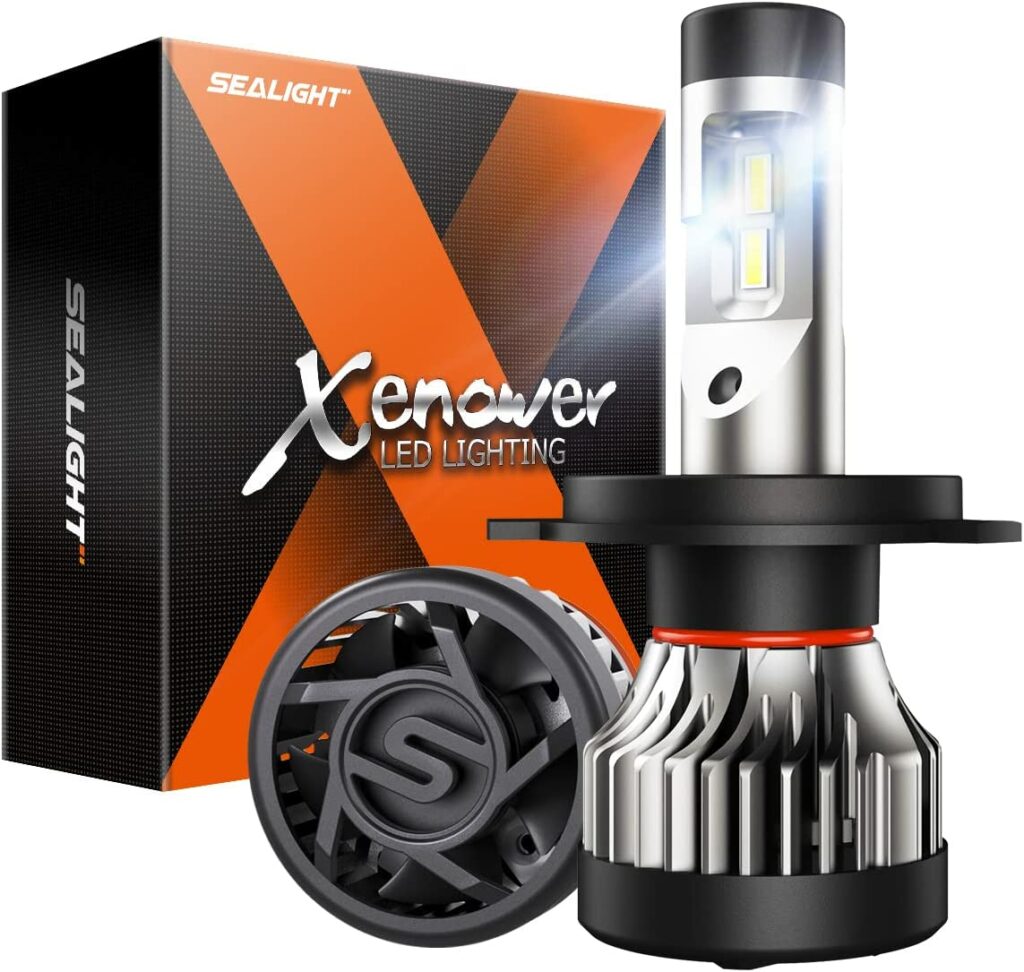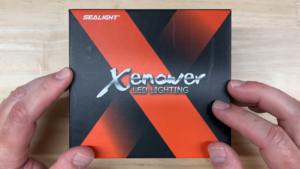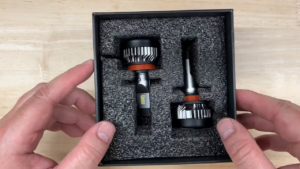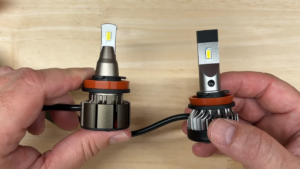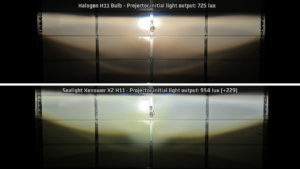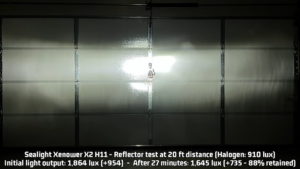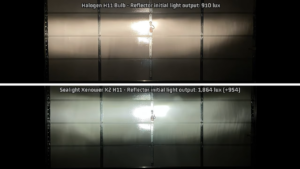This is my buying guide on the best LED headlight bulbs for the Toyota Tundra in 2024. Below is a quick summary of my top recommendations. Scroll further down to read my in depth, hands on reviews, for each headlight brand. See real world tests and photos below.
BUDGET
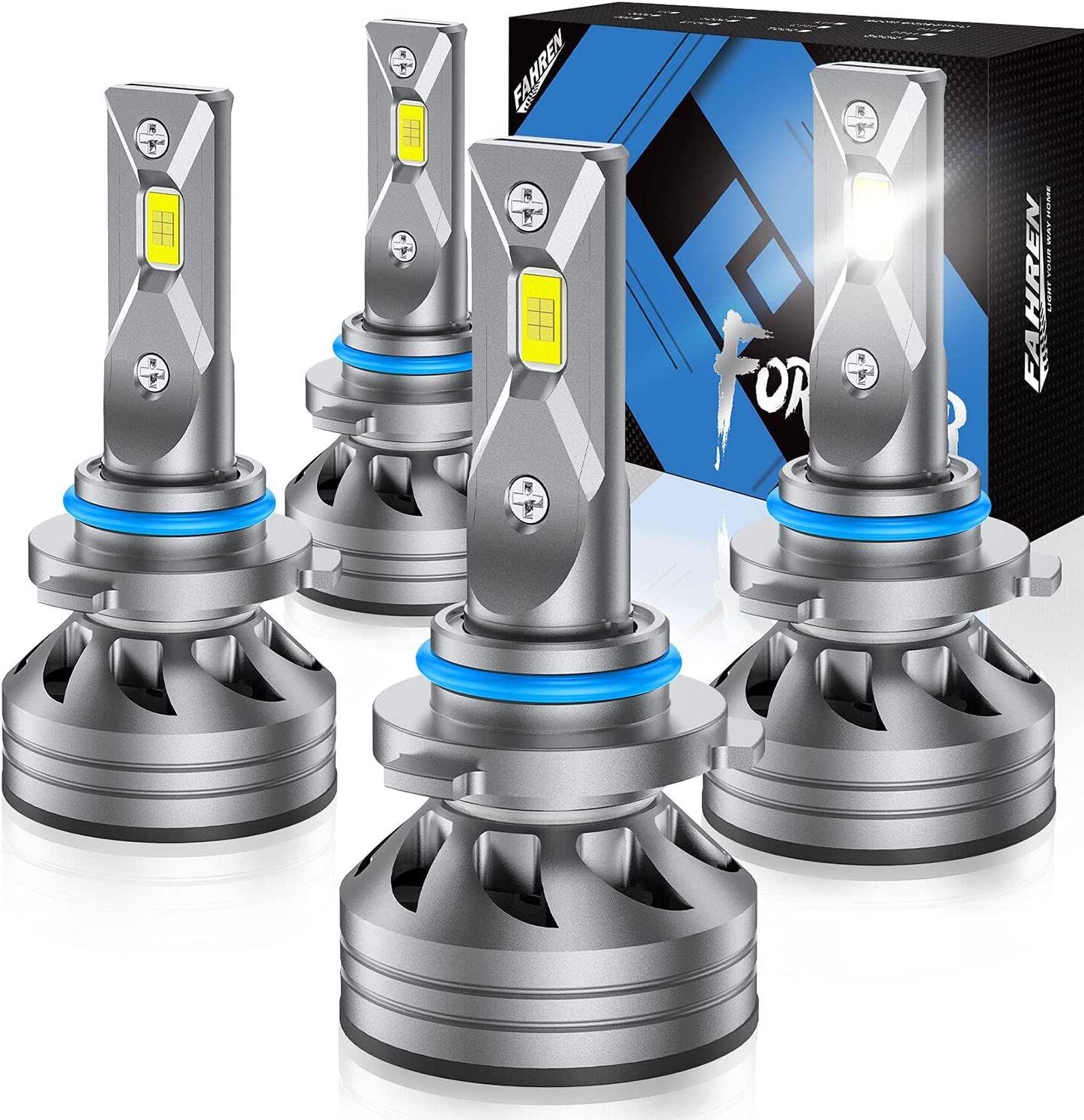
Fahren Forscher 9003/H4
LED Headlight Bulbs
- Plug and play
- 12,000 lumens/set
- 6,500K Cool White
- +300% brighter than halogens (advertised)
- Best heat retention I’ve ever seen 89%
- Best budget 9003/H4 LEDs
- 50,000-hour lifespan
- 70W per set
- External driver
- Space-age-looking silver design
- Built-in 12,000 RPM turbofan
- IP68 Water resistant
- 1-year warranty
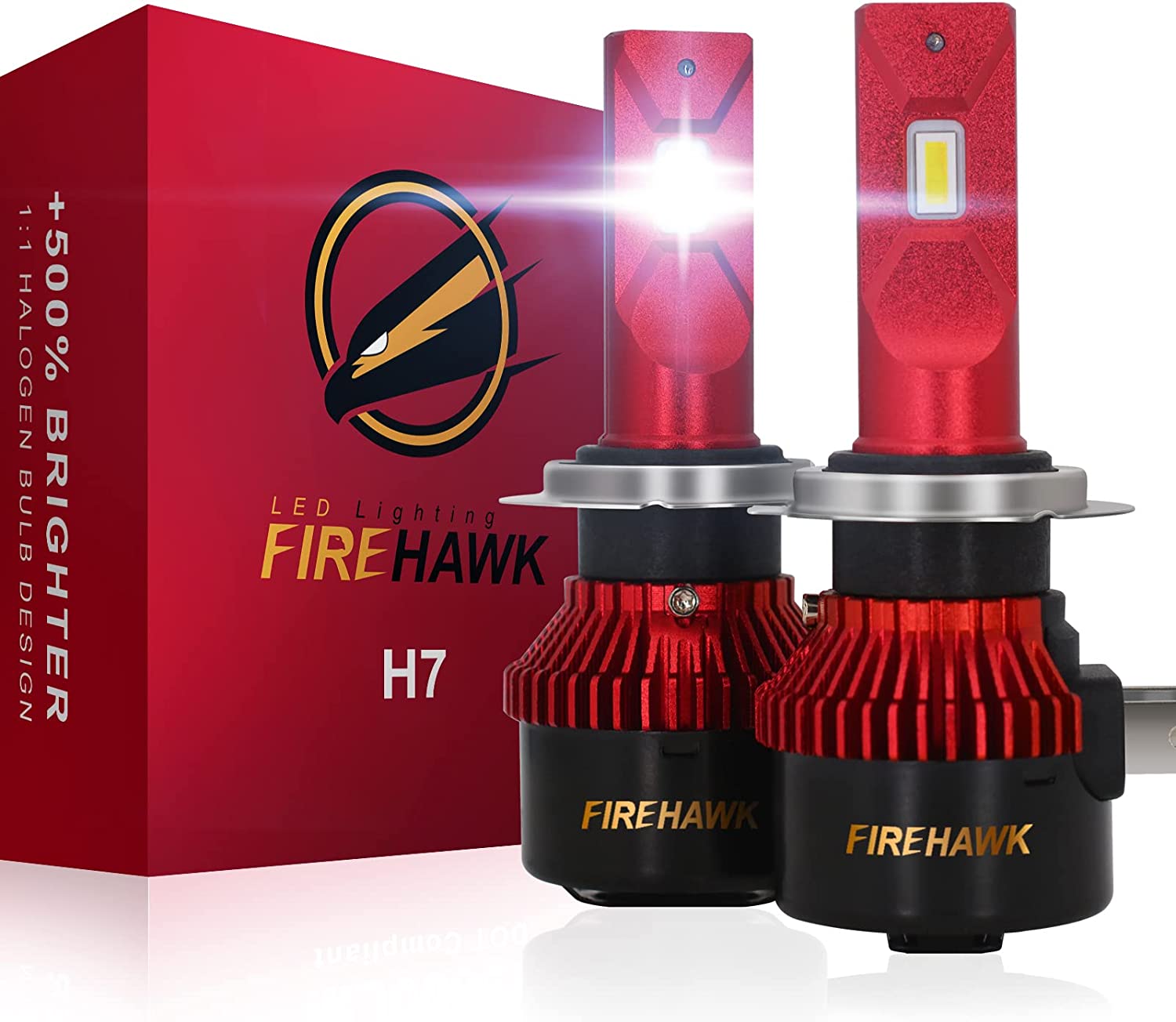
Firehawk 2023 9003/H4 LED Headlight Bulbs
- Plug and play
- 20,000 lumens/set
- Unique red copper finish
- Perfect beam pattern
- 6,000K Cool White
- +500% brighter than halogens (advertised)
- Best overall 9003/H4 LEDs
- 50,000-hour lifespan
- 62W per set
- All-in-one unit
- Built-in 12,000 RPM turbo cooling fan
- Excellent heat management
- IP68 Water resistant
- 2-year warranty
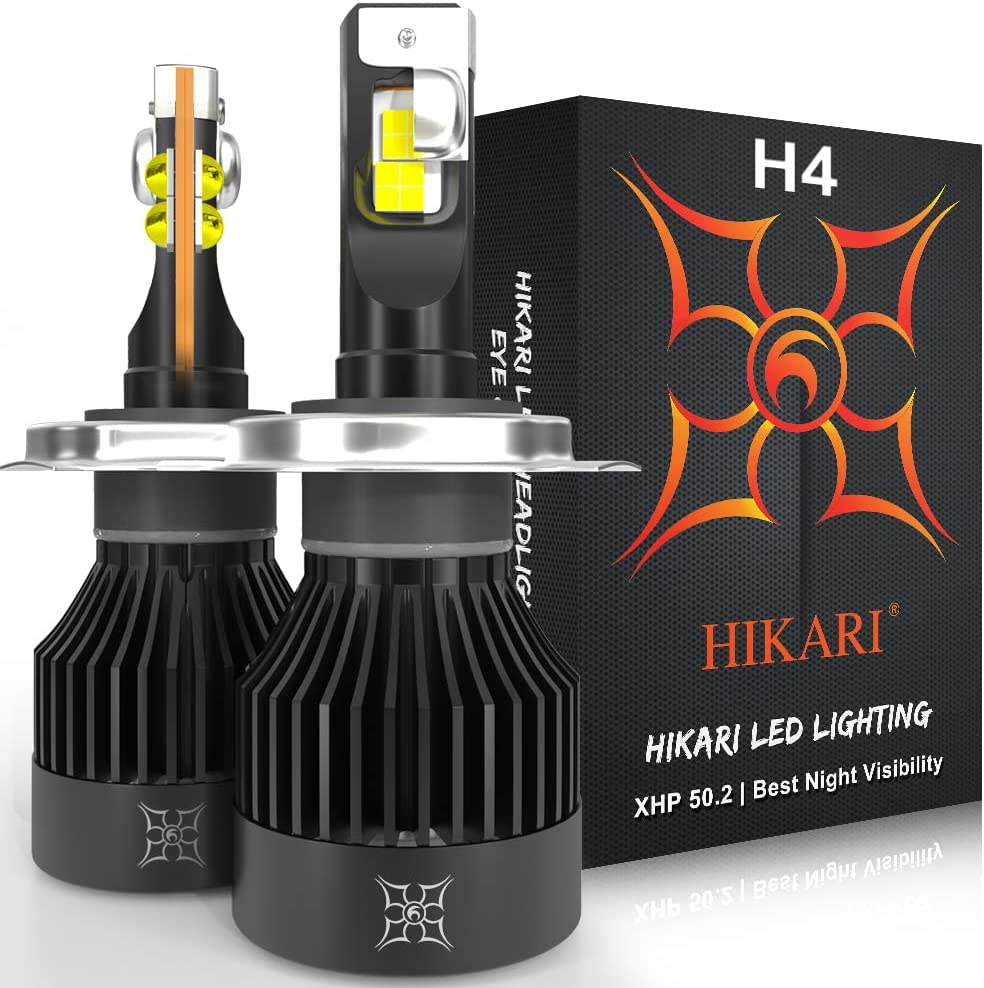
Sealight X2 H4/9003 LED
Headlight Bulbs
- Plug and play
- 20,000 lumens/set
- 6,500K Cool White
- +600% brighter than halogens (advertised)
- Excellent heat retention at 88%
- Runner-up for best H4/9003 LEDs
- 60,000-hour lifespan
- 150W per set (advertised)
- Compact external driver takes up less space
- Built-in 20,000 RPM turbo cooling fan
- IP68 Water resistant
- 1-year warranty
The Toyota Tundra has been named the most American-made full-size pickup truck.
Like with any truck, replacement parts are needed regularly; that goes for headlights too.
When the factory halogens burn out on a Toyota Tundra, it’s time to upgrade. And I recommend going for the 9003/H4 LED bulbs, as they’re brighter, whiter, and last longer.
For more than ten years, I’ve been testing car and truck headlight bulbs and can advise on the good vs. the bad.
I tested a stack of 9003/H4s and narrowed it down to three. The Firehawk bulbs are my favorites.
I’ll follow those with a runner-up for best and a budget option.
It’s time to find out the best 9003/H4 LED headlight bulbs for a Toyota Tundra.
Important note
I don’t personally own a Toyota Tundra, however for this review I borrowed my friend’s Tundra to test the bulbs to see how they performed and worked.
Top Choice
The Firehawk 2023 9003/H4 LED headlight bulbs stand out as my favorite pick for the best overall headlight bulbs for a Toyota Tundra. Their outstanding brightness and superior heat retention put them in a league of their own.
Promised Features
The Firehawk 2023 9003/H4 bulbs, made with Japanese Chips, boast an impressive 20,000 lumens per set, promising a leap of 500% in brightness compared to standard halogens.
What really impresses is their highly-focused beam pattern, which steers clear of dazzling other road users and doesn’t leave any dark spots or shadows.
The Kelvin color is another reason why I advocate for LEDs. Factory-fitted halogens clock in at 3,000K, casting an amber/yellow hue. These Firehawk 9003/H4 LED bulbs, however, emit a 6000K cool white light, lending sharper clarity to objects ahead.
In the fight against heat, the bulbs are armed with 40 pieces of aviation aluminum heat sinks, thickened red copper that’s 2mm in diameter, and a silent 12,000 RPM turbofan. Given that they only consume 31 watts each, power draw isn’t a concern.
But the question is – do all these features keep the bulb cool? I’ll share my test results in a bit.
Firehawk provides a 2-year warranty for these bulbs, backing them for up to 50,000 hours of use. While I haven’t seen any bulbs last quite that long, I know I’m not alone in this experience.
Their waterproof rating stands at a perfect IP68, which means your Tundra can weather any storm – rain, snow, or fog.
Oh, and they fitted like a glove in my buddy’s Toyota Tundra.
My Personal Take
Firehawk produces some pretty striking bulbs that demand attention. The distinctive red copper finish sets them apart from their rivals. While this feature might be hidden once installed in your Tundra, it sure does add a cool factor.
The materials used don’t seem particularly high-tech; they appear to be fairly standard.
The bulbs come as a compact unit with a built-in CAN bus driver and an adjustable collar, simplifying the installation process for the Tundra to a simple plug-and-play task. It should take less than ten minutes to install.
My only apprehension centered around the fan’s relatively small size; I couldn’t help but question if it was sufficiently large to effectively cool the bulbs.
Putting it to the Test
To ensure consistency, I stick to the same testing procedure for all bulbs. I positioned a lux meter 20 feet from the bulbs and compared these results to those from standard halogens.
Typical halogens score a lux rating of 725 in the projector test and 910 in the reflector test.
So, how did the Firehawk 2023 9003/H4 bulbs measure up? Exceptionally well, I must say!
In the projector test, they began with a lux rating of 1,332 – nearly twice as bright as halogens.
Impressively, after 27 minutes (the average American commute), they only dropped to 1,172 lux or 88%, significantly higher than the usual 78% retention. This suggests exceptional heat retention, potentially lengthening their lifespan.
In the reflector test, they started with an output of 2,280 lux, 250% brighter than halogens. While not quite hitting the advertised 500%, it’s still a commendable improvement for the Tundra’s headlights.
These bulbs also feature an impressive beam pattern. The hot spot is low, which is great. I noticed minor scattering at the top center and bottom left, but otherwise, the beam was clear and broad.
The measured wattage came in at 29, quite close to the advertised 31 watts. Kudos to Firehawk.
My initial concern about the compact fan turned out to be unfounded. After 27 minutes, the unit’s temperature was a cool 122°F, which is excellent heat management. Considering this, these bulbs should have a long lifespan.
What the Crowd Says
More than 5,000 drivers give the Firehawk 2023 9003/H4 LED bulbs an average rating of 4.4/5 stars.
What users appreciate the most is the bulbs’ exceptional brightness, their approval of the beam pattern, and the improved visibility due to the Kelvin color.
As expected, most report that the bulbs don’t last the full 50,000 hours, but I think that’s more of a universal marketing claim.
Wrapping Up
For a Toyota Tundra, I strongly advise ditching the factory halogens in favor of the Firehawk 9003/H4 LED bulbs. With their extraordinary brightness and remarkable heat management, these bulbs are set to serve you well for a long time.
Pros
- Plug and play
- 20,000 lumens/set
- Unique red copper finish
- Perfect beam pattern
- 6,000K Cool White
- +500% brighter than halogens (advertised)
- Best overall 9003/H4 LEDs
- 50,000-hour lifespan
- 62W per set
- All-in-one unit
- Built-in 12,000 RPM turbo cooling fan
- Excellent heat management
- IP68 Water resistant
- 2-year warranty
A Close Second
The Sealight X2 H4/9003 bulbs take second place on my list of best replacement headlights for a Toyota Tundra.
The Inside Scoop
Sealight is known for its quality headlights, albeit the marketing department tends to overstate the product specs a tad. I put these bulbs to the test with my buddy’s Tundra, and they performed admirably.
These X2 H4/9003 bulbs are pitched as a set of 20,000 lumens and supposedly deliver 600% more brightness than halogens. A lofty claim indeed! How accurate is it? I’ll reveal my test results shortly.
The bulbs harness an advanced LED chip to produce a seamless light output source, thereby improving beam accuracy.
The Kelvin color is 6,500 cool white, which should highlight objects in front of the truck with better clarity.
A 20,000 RPM turbofan and a smart temperature control chip cool these bulbs. Each chip is reportedly 75 watts, but my tests unveiled a significantly different figure.
Sealight pushes the envelope with longevity claims as well, promising a whopping 60,000 hours. However, they only back this up with a 1-year warranty.
One of my peeves is the lack of an IP rating, making it difficult to ascertain the durability of these headlight bulbs.
My Personal Insights
Setting the marketing exaggeration aside, these bulbs are truly top-notch for a Toyota Tundra.
Opening the box, I found rubber gloves, zip ties, and double-sided tape to fasten the external driver — nice touches, Sealight!
The bulbs are solidly built, and I appreciate the branding on the fan cover.
The heat fan seems a bit shallow, and similar to the Firehawk bulbs, I was a tad worried about its efficacy.
I was glad to see a compact external driver, as it would simplify the installation process in the Tundra.
My Real-World Tests
Does the product measure up to the hype?
The Sealight X2 H4/9003 LEDs scored an initial lux rating of 954 lux, outshining halogens by 249 lux — that’s 130% brighter.
Impressively, they also held on to 88% of their brightness after 27 minutes, dipping to 842 lux, which echoes the performance of the Firehawks.
In the reflector test, they started with a rating of 1,864 lux. While this is definitely 200% brighter than halogens, it falls far short of the claimed 600%.
After 27 minutes, they preserved 88% heat retention at 1,645 lux.
I was pleased with the beam pattern, which well illuminated the typically weak spot in the lower center.
However, the very high cutoff was a downside, and I suspect these bulbs might not extend as far down the road as others. I also noticed some scatter on the upper and lower left sides of the beam pattern.
Contrary to the advertised 75 watts, I recorded a wattage of only 34.8 per bulb, suggesting that 75 watts may be the total set capacity.
Much like the Firehawks, these bulbs exhibited superior heat management. After 27 minutes, the main unit was a cool 113°F, and the driver was 123°F.
Their heat retention hints at a potentially long lifespan, but I remain skeptical about them reaching the projected 60,000 hours.
What the Community Thinks
The Sealight X2 H4/9003 headlight bulbs enjoy an impressive rating of 4.6/5 stars, with most Tundra owners singing their praises.
Users commend their remarkable brightness and excellent beam pattern.
Predictably, these bulbs fall short of the advertised 60,000-hour lifespan.
The Bottom Line
As the worthy runner-up, the Sealight X2 H4/9003 headlight bulbs deliver efficient performance, an excellent beam pattern, and fantastic heat management. While they are quite reliable, they just don’t quite match the Firehawk bulbs in terms of brightness.
Pros
- Plug and play
- 20,000 lumens/set
- 6,500K Cool White
- +600% brighter than halogens (advertised)
- Excellent heat retention at 88%
- Runner-up for best H4/9003 LEDs
- 60,000-hour lifespan
- 150W per set (advertised)
- Compact external driver takes up less space
- Built-in 20,000 RPM turbo cooling fan
- IP68 Water resistant
- 1-year warranty
Best for Your Wallet
If you’re looking for a budget-friendly pick, the Fahren Forscher 9003/H4 LED headlight bulbs offer a great deal, coming in at less than $50 a pair for your Toyota Tundra.
Specifications
Fahren makes the claim that its 9003/H4 headlight bulbs pack 12,000 lumens per set and boast a brightness that’s 300% that of halogens.
The chip pumps out a super-focused beam pattern, promising a wider and farther lighting range.
Like the Firehawks and the Sealights, these also feature a cool white 6500K Kelvin color. Objects in front of the Tundra definitely seemed clearer than with halogens.
With an aviation aluminum body and a distinctive hollow-carved heat sink accompanied by a 12,000 RPM turbofan, these bulbs utilize 70 watts of power per set, which seems about right.
But does all this keep the heat under control? I’ll dive into my test results in a bit.
The company ups the ante with yet another claim of a 50,000-hour lifespan, which is starting to seem like the industry standard. Fahren backs this up with a mere 1-year warranty.
A neat perk, like the Firehawks, these bulbs are also IP68 waterproof, so taking your Tundra out in any weather condition won’t be an issue.
My First Impressions
Upon opening the box, I was met with a detailed user manual full of images. A bit overkill, in my opinion, given these are simple plug-and-play units.
Fahren’s headlight bulbs generally stick to a traditional design, but these 9003/H4 LEDs have a bit of a futuristic flair. With a noticeable amount of silver, they give off a robust and reliable vibe.
Fahren remains mum on the bulb’s chip details, only mentioning that they’re of top automotive-grade.
The heat sink design caught my eye – sleek and tidy. Sure, once it’s tucked away in the Tundra, it’s out of sight, but I know it’s there.
Like the Sealight, the external driver is compact and has a reassuring solidity to it.
However, the turbofan does come with a minor glitch, which could explain the budget-friendly price tag. Let’s get into the details.
My In-the-Field Tests
The projector test showed an initial rating of 1,417 lux – almost double the brightness of halogens straight off the bat!
Keeping up with the Firehawks and the Sealight, these bulbs also showcase excellent heat retention. They even up the ante by 1%, dropping to only 1,313 lux or maintaining 89% of their brightness after 27 minutes. This is the highest heat retention level I’ve tested to date!
The reflector recorded an initial 2,390 lux, dipping to 2,137 after 27 minutes.
The beam pattern is well regulated. I only noted minor patchiness in the top and bottom center, the usual weak spots.
I recorded a wattage of just 25.9, lower than the advertised 35 watts. But this could be the secret behind the superior heat retention.
After 27 minutes, I measured the main unit’s temperature at 185°F, a bit on the high side. However, the driver remained at a much cooler 120°F.
Now, for the hitch – the turbofan is a bit on the noisy side. I’ve heard similar feedback from other drivers, so it’s not just my unit.
It’s a pity because apart from this, the bulb performance is commendable.
The Word on the Street
The Fahren Forscher 9003/H4 bulbs enjoy immense popularity, with over 50,000 ratings and an average of 4.5/5 stars.
Drivers rave about their brightness and appreciate the extra clarity the Kelvin white provides.
However, the noisy fan does get quite a few mentions and seems to be a significant concern for many.
The Final Verdict
For a bargain price, the Fahren Forscher 9003/H4 LED bulbs are a fantastic choice if you’re not put off by the noisy fan. For the budget-conscious Toyota Tundra driver, these bulbs could be just the ticket.
Pros
- Plug and play
- 12,000 lumens/set
- 6,500K Cool White
- +300% brighter than halogens (advertised)
- Best heat retention I’ve ever seen 89%
- Best budget 9003/H4 LEDs
- 50,000-hour lifespan
- 70W per set
- External driver
- Space-age-looking silver design
- Built-in 12,000 RPM turbofan
- IP68 Water resistant
- 1-year warranty
Cons
- Noisy fan
Toyota Tundra Headlight Bulbs FAQ
Here are the four most commonly asked questions about Toyota Tundra headlight bulbs.
What size bulbs does the Toyota Tundra use?
The Toyota Tundra has a dual beam fit out, which means one bulb does the work of both high and low beams with the flick of a switch.
The bulb needs to be bright enough to act as a high beam, so the one that works best is the 9003, also known as the H4 or H2.
What’s the best Toyota Tundra headlight upgrade?
I recommend upgrading from factory halogens to LEDs, as they’re considerably brighter and whiter.
Standard halogen 9003 bulbs have around 1,000 lumens; LED 9003s begin at 5,000 lumens and go up to more than double that.
Factory halogens also have a Kelvin color of around 3,000, which is an amber/yellow color. LEDs start around the 6,000K mark, which is white. This color is much more suited for being able to spot objects in front of the truck faster and with more clarity.
Will my Toyota Tundra need a conversion kit if I’m using LED Headlight Bulbs?
The light fittings of a Toyota Tundra are designed for the factory-installed halogens they come with. Upgrading to LEDs may require a conversion kit for some makes and models, as the bulb may not comfortably fit inside the housing.
A conversion kit comes with items like ballasts, a writing adapter, and heat sinks, which can all assist with installation if required.
Are there any drawbacks to using LED headlight bulbs for my Toyota Tundra?
As LED bulbs are so bright, the beam must be angled correctly. This also applies to the 9003/H4 LED headlight replacement bulbs for a Toyota Tundra.
If these are not angled properly, they could cause glare and temporarily blind oncoming drivers. For safety reasons, always aim the light beams correctly.
